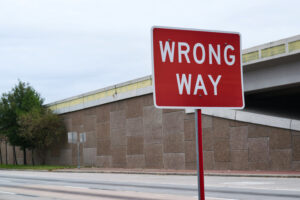Wrong-way driving crashes are among the most dangerous incidents on Florida’s roads, often resulting in catastrophic head-on collisions with devastating consequences. Understanding how to avoid these situations and respond appropriately can be the difference between life and death.
consequences. Understanding how to avoid these situations and respond appropriately can be the difference between life and death.
The Stark Reality
Florida’s Department of Transportation (FDOT) reports that, “While wrong-way driving crashes occur randomly and less frequently than other types of crashes, they often involve more than one vehicle and can result in multiple fatalities and/or serious injuries.” Driver impairment from alcohol or drugs is the predominant factor in these crashes, though confusion, elderly drivers, and distraction also contribute. Most wrong-way incidents occur between midnight and 6 A.M., when reduced visibility combines with higher rates of impairment to create deadly conditions.
If You Realize You’re Going the Wrong Way
Finding yourself driving against traffic is terrifying, but your response can prevent tragedy. FDOT provides clear guidance: stop immediately, pull over to the side of the road, and turn around when it is safe to do so. Never try to back up on a highway or interstate the goal is to get out of traffic’s path as quickly and safely as possible.
When You Encounter a Wrong-Way Driver
Spotting a wrong-way driver, or seeing an alert on electronic message boards, requires immediate defensive action. Use caution and reduce your speed to give yourself more reaction time. Pull over to the rightmost lane or completely off the roadway if safe. Call 911 immediately to report the incident, providing your location, direction of travel, and vehicle description. Avoid sudden movements, as wrong-way drivers may be impaired or confused, making their actions unpredictable.
Prevention Strategies
Most wrong-way entries occur at highway ramps, particularly during nighttime hours when visibility is reduced and signage may be harder to see. To avoid becoming a wrong-way driver:
- Pay attention at ramps and intersections. Look for “Wrong Way” and “Do Not Enter” signs, especially when tired or in unfamiliar areas.
- Follow pavement markings. Lane arrows and divider lines are designed to guide traffic in the correct direction.
- Avoid Distractions. Keep full attention on the road, particularly in unfamiliar areas or at night.
- Do not drive when impaired or extremely fatigued. Many wrong-way incidents involve alcohol or driver fatigue.
- Use GPS navigation carefully. Don’t blindly follow directions verify they make sense with road signs and traffic patterns.
Wrong-way driving crashes are preventable tragedies that destroy families and communities. By staying alert, following traffic laws, and knowing how to respond in these dangerous situations, we can all help make Florida’s roads safer.


